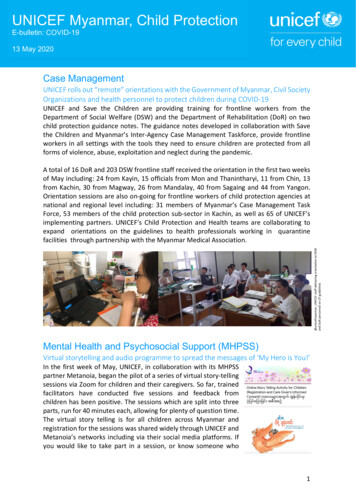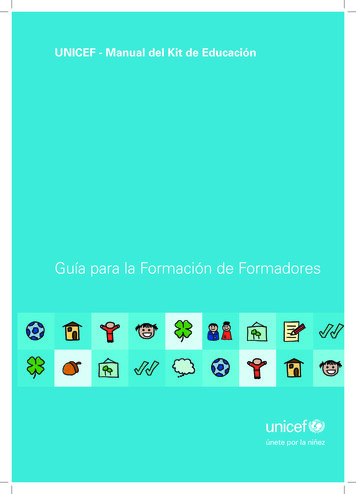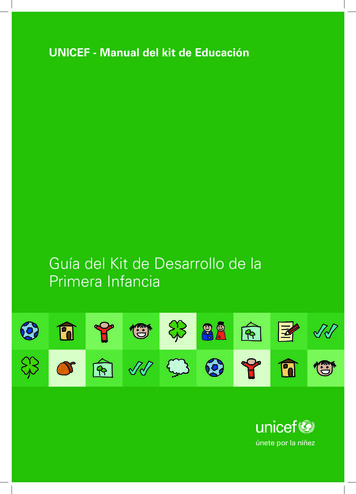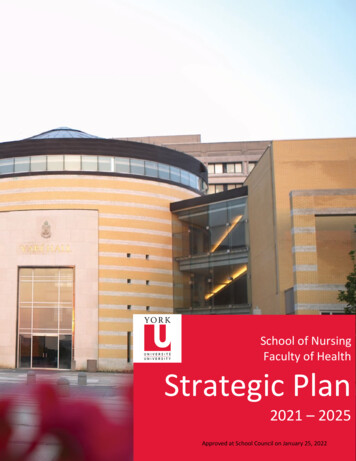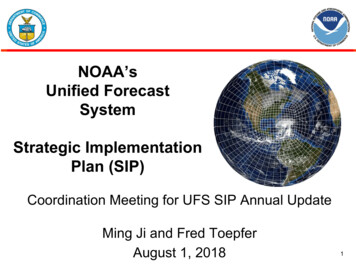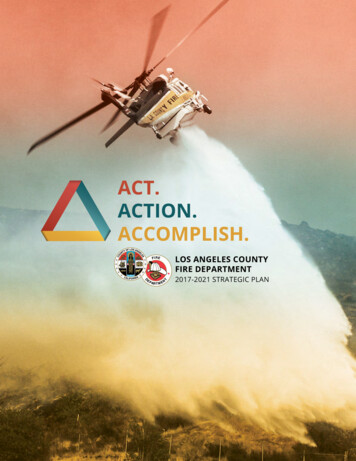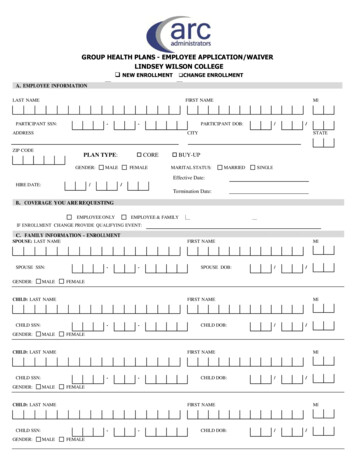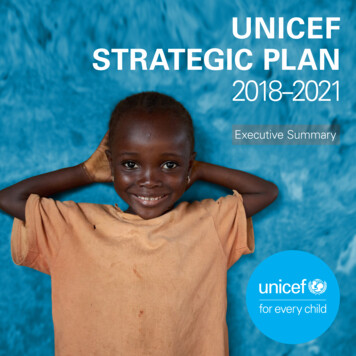
Transcription
UNICEFSTRATEGIC PLAN2018–2021Executive Summary
“For over 70 years, UNICEF has been a champion for children and youngpeople – from reaching starving children after World War II, to igniting thechild survival revolution in the 1980s, to renewing the global fight againstinequity in recent years. Whatever the challenge, UNICEF’s focus has alwaysbeen on achieving results – real results that save children’s lives and createnew opportunities for young people to fulfil their potential. Our ambitious newStrategic Plan will help us achieve even greater results as we work with ourpartners to attain the 2030 Sustainable Development Goals. To realize the SDGs’vision of a world in which no one is left behind, we need to go beyond businessas usual – investing in innovation and building broader, bolder partnerships thathelp us reach every child.”UNICEF Executive Director Henrietta H. ForePublished by UNICEF, Division of Communication3 United Nations Plaza, New York, NY 10017, USApubdoc@unicef.orgwww.unicef.orgThe planned results cited in this publication are just a sampling ofthe results to be achieved through UNICEF-supported programmesby 2021, building on baselines drawn from the latest available data.Front cover: A young girl stands against awall in the village of Gondama, Bo District,Sierra Leone. UNICEF/UN0152818/PHELPS United Nations Children’s Fund, January 2018.Facing page: Syrian refugee girls studywith Italian friends at a public elementaryschool in Trentino Province, Italy.ISBN: 978-92-806-4951-2 UNICEF/UN069359/ROMENZI
CONTENTSUNICEF for every child. . . . . . . . . . . . . . . . . . . . . . . . . . . . . . . . . . . . . . . 2Why does the UNICEF Strategic Plan matter? . . . . . . . . . . . . . . . . . . . . . . . 5Purpose of the UNICEF Strategic Plan, 2018–2021 . . . . . . . . . . . . . .The Strategic Plan and Agenda 2030. . . . . . . . . . . . . . . . . . . .89What results will the Strategic Plan help UNICEF achieve for children? . . . . . 11Every child survives and thrives. . . . . . . . . . . . . . . . . . . . .Every child learns . . . . . . . . . . . . . . . . . . . . . . . . . .Every child is protected from violence and exploitation. . . . . . . . . . . .Every child lives in a safe and clean environment . . . . . . . . . . . . . .Every child has an equitable chance in life. . . . . . . . . . . . . . . . .1314171821Two cross-cutting priorities. . . . . . . . . . . . . . . . . . . . . . . . . . . . . . . . . . . 22How will UNICEF achieve results for children?. . . . . . . . . . . . . . . . . . . . . . 25Eight change strategies . . . . . . . . . . . . . . . . . . . . . . . . 26Four organizational enablers to drive results . . . . . . . . . . . . . . . . 30Emerging issues: The crucial second decade32U N I C E F S T R AT E G I C P L A N , 2 0 18 – 2 0 211
UNICEF for every childThe driving focus of UNICEF’s Strategic Plan is achieving more results for children.More than 70 years since UNICEF was established in the aftermath of World War II, ourmission is as urgent as ever.Day in and day out, UNICEF works in 190 countries and territories, in some of thetoughest places on earth, to reach the children and young people in greatest need and atgreatest risk with life-saving assistance and long-term help, and to protect the rights ofevery child, everywhere.Anchored in the Convention on the Rights of the Child and building on the lessons wehave learned, the UNICEF Strategic Plan, 2018–2021 was developed to advance ourmission in a changing world. It sets out the concrete results we aim to achieve forchildren, together with our partners – in the United Nations, and with governments,civil society and the private sector. It defines the change strategies and enablers weneed to achieve them. For the first time, the Strategic Plan includes a Common Chapterthat specifies how we will work together with other UN funds and programmes. And itcharts a course for the next four years towards the attainment of the 2030 SustainableDevelopment Goals (SDGs) – and the realization of a better world for every child.2U N I C E F S T R AT E G I C P L A N , 2 0 18 – 2 0 21
Children ride in a helicopterchartered to reunite themwith their parents in Akobo,South Sudan. UNICEF/UN013997/RICHU N I C E F S T R AT E G I C P L A N , 2 0 18 – 2 0 213
A pre-term baby is treated in a specialcare unit at Tangail Medical CollegeHospital, Bangladesh. UNICEF/UNI195710/MAWA
Why does the UNICEFstrategic plan matter?The world has made tremendous progress in advancing the rights and improving the lives of children over thepast few decades. The number of children dying before their fifth birthday declined by more than half between 1990 and 2015. The proportion of children enrolled in primary school in low- and middle-income countries reached91 per cent in 2015, up from 83 per cent in 1990.Stunting prevalence among children under age 5 fell from approximately 33 per cent to approximately23 per cent – representing 43 million fewer stunted children.But persistent inequities and lack of opportunity continue to endanger the lives and futures of millions ofchildren around the world. Compared to children growing up in the wealthiest households, the poorestchildren are: Twice as likely to die before reaching the age of five.Twice as likely to be stunted.Five times as likely to be out of school.Girls, children with disabilities and children from minority groups are more likely to be marginalized andexcluded. Adolescent girls are more likely to be illiterate than adolescent boys.1 in 10 girls under the age of 20 has suffered sexual violence.Children with disabilities are more likely to be out of school.U N I C E F S T R AT E G I C P L A N , 2 0 18 – 2 0 215
And new challenges make vulnerable children even more vulnerable, threatening to rollback hard-won progress for the most disadvantaged children and young people:6 Humanitarian emergencies and extreme poverty are driving waves of displacement,with 28 million children displaced by violence and conflict in recent years. By 2030, one third of the world’s children will live in countries affected by fragilityand conflict. Climate change and environmental degradation are increasing the spread of diseaseslike malaria, as well as the scale of natural disasters. Globalization, urbanization and mass movements of people increase the risk ofepidemics like Ebola and Zika.U N I C E F S T R AT E G I C P L A N , 2 0 18 – 2 0 21
A boy walks home from school inKiribati – one of the countries mostaffected by rising sea levels. UNICEF/UN055820/SOKHINBut there are also trends that we can turn into opportunities to break down barriers thatendanger children and young people and prevent them from fulfilling their potential: Innovations in programming are increasing our ability to reach vulnerable children withvital goods, services and medical equipment more cost-effectively. Digital technology and social media are increasing our ability to reach and motivatesupporters around the world – and giving children and young people a platform todemand accountability and drive change. The role of the private sector and civil society is growing as we work together toimprove how we finance and deliver critical services.U N I C E F S T R AT E G I C P L A N , 2 0 18 – 2 0 217
The path forward will be challenging. To meet the SDGs by 2030, progress over the next 15 years will have toaccelerate – outpacing the rates of progress achieved during the Millennium Development Goals period.Without faster progress, by 2030:167 million children will still live in extreme poverty.60 million children of primary school age will still be out of school.69 million children under 5 will still die from causes we know how to prevent.UNICEF’s Strategic Plan, 2018–2021 was conceived in the context of these challenges and opportunities. Witha set of clear, focused goals tied to specific results, and change strategies to achieve them, the Strategic Planwill help us deepen the impact of our work for every child, starting with the most disadvantaged.PURPOSE OF THE UNICEF STRATEGIC PLAN, 2018–2021Building on lessons learned emphasizing UNICEF’s contribution to achieving the 2030 SDGs and recognizing the need to work across sectors with a focus on cross-cutting issues of equity,gender and sustainability, the Strategic Plan will increase UNICEF’s ability to deliver results forchildren in four key ways: Aligning our organization's resources around common goals and strategies. Supporting our ability to make strategic choices. Creating more effective communication about UNICEF’s work for every child to win more supportfor the cause of children. Strengthening our organization’s accountability framework.8U N I C E F S T R AT E G I C P L A N , 2 0 18 – 2 0 21
THE STRATEGIC PLAN AND AGENDA 2030Anchored in the Convention on the Rights of the Child, the 5 Goal Areas, 8 Change Strategies and 4 InternalEnablers of the UNICEF Strategic Plan, 2018–2021 are specifically keyed to drive progress towards theachievement of the 2030 Sustainable Development Goals – and thus, to help realize the SDGs' vision of aworld in which no one is left behind.Realizing the rights of every child, especially the most disadvantaged20302021GOAL AREA 1GOAL AREA 2GOAL AREA 3GOAL AREA 4GOAL AREA 5Every childsurvives andthrivesEvery childlearnsEvery childis protectedfrom violenceand exploitationEvery childlives in a safeand cleanenvironmentEvery childhas anequitablechance in lifeRESULT AREASHOW: Change strategiesENABLERS: help to deliver the WHAT and HOWU N I C E F S T R AT E G I C P L A N , 2 0 18 – 2 0 21 9
Young Rohingya refugees from Myanmar rest on a matat a settlement in Cox’s Bazar, Bangladesh. UNICEF/UN0143049/LEMOYNE10 U N I C E F S T R AT E G I C P L A N , 2 0 18 – 2 0 21
What results will thestrategic plan help UNICEFachieve for children?The overarching goal of the UNICEF Strategic Plan, 2018–2021 is to drive results for the most disadvantagedchildren and young people. Supported by 8 change strategies and tied to 25 results areas, the Strategic Planestablishes 5 goal areas:1Every childsurvives andthrives2345Every childlearnsEvery childis protectedfrom violenceand exploitationEvery childlives in a safeand cleanenvironmentEvery childhas anequitablechance in lifeThese goal areas span a child’s life cycle, encompassing antenatal care, through infancy, childhood andadolescence, giving priority to the most disadvantaged children. Equity for children is both a stand-alonegoal and a cross-cutting priority. The results areas target the key barriers that hold children and youngpeople back, deny them the agency to shape their destinies and prevent them from accessing criticalservices that can save their lives and help them fulfil their potential.U N I C E F S T R AT E G I C P L A N , 2 0 18 – 2 0 2111
A woman walks with onethe grandchildren shelooks after in SouthernProvince, Zambia. UNICEF/UN0144209/SCHERMBRUCKER12 U N I C E F S T R AT E G I C P L A N , 2 0 18 – 2 0 21
GOAL AREA 1EVERY CHILD SURVIVES AND THRIVESEvery child has the right to grow up healthy and strong.And yet, poverty, the environment, malnutrition and inaccessibleor inadequate care, maternal health and nurturing practicesprevent millions of children from surviving and thriving.In 2016, 15,000 children under 5 still died every day frompreventable causes – 7,000 of them in the first days of life.More than 40 per cent of children under 5 may not reach theirpotential.Planned results for 2021 include:120 MILLION30 MILLION6 MILLION80 COUNTRIES1.19 MILLIONbabies bornsafely at healthfacilities throughUNICEF-supportedprogrammes – upfrom 25 million.children ics throughUNICEF-supportedprogrammes – upfrom 6 million.girls and boyswith severe acutemalnutritionadmitted fortreatment – upfrom 3.4 million.having adopted,at scale, earlychildhooddevelopmentpackagespromoting earlystimulation andresponsive care– up from 9.pregnant womenliving with HIV givenaccess to treatmentand kept alive – upfrom 1.02 million.U N I C E F S T R AT E G I C P L A N , 2 0 18 – 2 0 2113
GOAL AREA 2EVERY CHILD LEARNSEvery child has the right to an education and quality learningopportunities from early childhood to adolescence. And yet, a rangeof factors – including geographic location, economic circumstances,gender, disability, low-quality teaching and schools, disruption fromconflicts and other shocks – prevent millions of children from learning.In 2016, more than half the world's children of preschool age,61 million children of primary school age, 60 million adolescents oflower secondary school age and 142 million adolescents of uppersecondary school age lacked access to learning opportunities.Conflict has forced approximately 27 million children out of school– and girls are 2.5 times more likely to be out of school than boys incountries affected by conflict.And an estimated 130 million children have reached Grade 4 withoutlearning basic reading and mathematics skills.Planned results for 2021 include:60 MILLION93 MILLION79 PER CENTout-of-school children gainingaccess to early learning, primaryor secondary education – upfrom 10 million.girls and boys provided withindividual education or earlylearning materials – upfrom 15.7 million.of countries showingimprovements in learningoutcomes for girls and boys – upfrom 62 per cent for girls and60 per cent for boys.14 U N I C E F S T R AT E G I C P L A N , 2 0 18 – 2 0 21
Two girls, one holdinga tablet computer, raisetheir hands to answer aquestion at a school inBagai, Cameroon. UNICEF/UN0143480/PRINSLOO
A teacher and studentinteract at a school formarginalized childrenin Dhaka District,Bangladesh. UNICEF/UN031216/KIRON16 U N I C E F S T R AT E G I C P L A N , 2 0 18 – 2 0 21
GOAL AREA 3EVERY CHILD IS PROTECTED FROM VIOLENCEAND EXPLOITATIONEvery child has the right to be protected from violence,exploitation and abuse. And yet, social norms, culturalpractices, intra-state conflict and displacement, and otherharmful actions undermine children’s safety and well-being inevery country.In 2016, up to 1 billion girls and boys experienced some form ofviolence or harmful practice, including sexual violence. Almost750 million girls and women were married as children, and atleast 200 million women and girls were subjected to femalegenital mutilation/cutting. Gender-based violence continues tobe one of the most pervasive violations of human rights in theworld. And humanitarian crises make vulnerable children evenmore vulnerable to harm.Planned results for 2021 include:80 PER CENT5.1 MILLION157 COUNTRIESof unaccompanied and separatedgirls and boys targeted byUNICEF registered with familytracing and reunification servicesand family-based care orappropriate alternative services –up from 41 per cent.migrant, refugee and displacedchildren receiving protectiveservices through UNICEFsupported programmes – upfrom 1.8 million.providing free and universal birthregistration services within civilregistration systems to givechildren a legal identity and helpprotect them from exploitation– up from 131.U N I C E F S T R AT E G I C P L A N , 2 0 18 – 2 0 2117
GOAL AREA 4EVERY CHILD LIVES IN A SAFE AND CLEANENVIRONMENTEvery child has a right to live in an environment that isconducive to his or her growth and safety, including beingprotected from pollutants and other hazards. And yet,climate change, weak local and national governance, unplannedurbanization and insufficient awareness of the dangers posed byenvironmental risks – including inadequate water and sanitationsystems – expose millions of children to potential harm.Around the world today, an estimated 2.4 billion people –women, men, girls and boys – still lack access to improvedsanitation. More than 660 million lack access to improveddrinking water sources. Nearly 160 million children live in high orextremely high drought severity zones, while around 300 millionchildren live in areas with toxic levels of air pollution.Planned results for 2021 include:60 MILLION250 MILLION25 COUNTRIESadditional people gaining accessto safe drinking water sources.fewer people practising opendefecation.implementing child-sensitivenational plans for climatechange adaptation or mitigation– up from 5.18 U N I C E F S T R AT E G I C P L A N , 2 0 18 – 2 0 21
Family members share alaugh at home in the city of ElAlto, near La Paz, Bolivia. UNICEF/UNI189313/GILBERTSON VII PHOTOU N I C E F S T R AT E G I C P L A N , 2 0 18 – 2 0 2119
A refugee from Afghanistanholds her six-month-olddaughter at an emergencyshelter in Vienna, Austria. UNICEF/UN05475/GILBERTSON VII PHOTO.
GOAL AREA 5EVERY CHILD HAS AN EQUITABLE CHANCE IN LIFEEvery child has the right to fulfil his or her potential. And yet,extreme poverty, geography, conflict, discrimination, exclusionand other barriers hold back millions of children around the world,with lifelong consequences for themselves and their societies asinequity and deprivation perpetuate poverty across generations.Today, nearly 385 million children live in extreme poverty, which isexacerbated by a range of factors such as conflicts, crises and theintensifying effects of climate change.Planned results for 2021 include:77 MILLION172 MILLION69 COUNTRIESfewer children living inextreme poverty in low- andmiddle-income countries –down from approximately385 million.vulnerable children beingreached by UNICEF-supportedcash transfer programmes –up from 160 million.having national systems inplace to measure and reporton multidimensional childpoverty – up from 38.U N I C E F S T R AT E G I C P L A N , 2 0 18 – 2 0 2121
Two cross-cutting prioritiesHumanitarian action and gender equality are integrated into everything UNICEF does, because we havelearned that this is the most effective way of making sustained progress in all areas of our work, and becauseresilient communities and empowered girls and women are prerequisites for all sustainable development.1.HUMANITARIAN ACTIONUNICEF’s work to reach children trapped in humanitarian emergencies is at the core of our mission andmandate. But in a world where crises and conflicts are increasing in frequency, severity and duration,humanitarian work must also help lay the foundation for the long-term resilience of communities andfamilies – by strengthening health and protection systems, providing families with cash transfers tomanage in crises and providing learning and support for children caught up in emergencies. At thesame time, our development work must help reduce needs, vulnerabilities and risks over the long termto protect children against future shocks.Under the Strategic Plan, we will: STRENGTHEN delivery of faster, more effective and at-scale humanitarian response, withan increased emphasis on adaptations to improve our response to health emergencies, massdisplacements and protracted crises. FOCUS more systematically on community engagement and accountability to affected people andcommunities, including through communication for development and platforms for adolescent participation. ENHANCE risk-informed programming, including investments in preparedness, and advocacy for riskreduction in development plans and sector policies. STRENGTHEN coherence and complementarity between humanitarian action and developmentprogramming22 U N I C E F S T R AT E G I C P L A N , 2 0 18 – 2 0 21
CROSS-CUTTING PRIORITIES: THE HUMANITARIAN-DEVELOPMENT NEXUS AND GENDER EQUALITY2.GENDER EQUALITYHealthy, educated and empowered girls and women are critical to all sustainable developmentand strong societies. A sizeable evidence base shows that the well-being of children is mostdependent on women’s survival, protection and opportunity. Building on UNICEF’s Gender ActionPlan, 2018–2021, as well as system-wide efforts to promote gender equality, the Strategic Planintegrates gender in each of its five goal areas.Under the Strategic Plan, we will: EMPHASIZE gender discriminatory roles and practices. MAINSTREAM gender analysis in programme design and delivery. ACHIEVE gender parity in internal staffing and capacity development. OVERCOME barriers to the empowerment of adolescent girls, in particular. ENGAGE with men and boys, and change social norms to address the root causes of genderbased discrimination.U N I C E F S T R AT E G I C P L A N , 2 0 18 – 2 0 2123
In Aden, Yemen, a child’sarm is measured todetermine whether hesuffers from malnutrition. UNICEF/UN078075/FUAD24 U N I C E F S T R AT E G I C P L A N , 2 0 18 – 2 0 21
How will UNICEF achieveresults for children?UNICEF delivers change by combining high-quality programmes at scale, harnessing innovationand collecting evidence, in partnership with governments, other United Nations organizations,civil society, the private sector, communities and children. It leverages wider change nationally andglobally through advocacy, communications and campaigning. UNICEF also builds public supportaround the world, encouraging people to volunteer, advocate and mobilize resources for the cause ofchildren, and works with partners to achieve even greater impact.The UNICEF Strategic Plan identifies eight change stategies and four organizational enablers todrive results:FOUR ORGANIZATIONAL ENABLERSEIGHT CHANGE STRATEGIES1.Programming excellence for at-scale resultsfor children2. Gender-responsive programming3. Winning support for the cause of children fromdecision-makers and the wider public4. Developing and leveraging resources andpartnerships for children1.Responsive, transparent and accountableinternal governance2. Results-oriented, efficient and effectivemanagement3. Staff capacity to drive change for children4. Versatile, safe and secure knowledge andinformation systems5. Leveraging the power of business and marketsfor children6. United Nations working together7.Fostering innovation in programming andadvocacy for children8. Using the power of evidence to drive changefor childrenU N I C E F S T R AT E G I C P L A N , 2 0 18 – 2 0 2125
EIGHT CHANGE STRATEGIES1CHANGE STRATEGYPROGRAMMING AT-SCALERESULTS FOR CHILDRENUNICEF’s programme work in the field is the core of ourorganization and the foundation of our ability to drive change forchildren. Under the Strategic Plan, we will increase our ability to: Foster cross-sectoral and multi-sectoral programmingthat responds holistically to children’s needs and to theenvironments in which they grow up. Support policy, capacity development and systemsstrengthening at both national and subnational levels,especially in humanitarian situations, to enable morerapid scale-up and delivery of life-saving and childprotective services, and to improve readiness to scaleup cash transfers to families affected by emergencies. Enhance coherence and connectedness betweenhumanitarian action and longer-term programming –including analyses of risks related to disaster, conflict,climate change and other shocks – and build responsiveprogramming with partners to support preparedness,increase recovery and build resilience against future shocks. Engage with communities to promote behaviour change,increase demand for quality services and support socialnorms that contribute to the realization of child rights,directly and through policy and systems strengthening,including adaptations for humanitarian response. Promote cooperation, share lessons learned and bestpractices and foster innovation among countries andacross regions.26 U N I C E F S T R AT E G I C P L A N , 2 0 18 – 2 0 212CHANGE STRATEGYGENDER-RESPONSIVEPROGRAMMINGUNICEF will strengthen themainstreaming of gender equality acrossthe organization, in line with our GenderAction Plan, 2018–2021, working withour United Nations partners. Under theStrategic Plan, we will: Strengthen gender-responsiveprogramming in all areas ofUNICEF’s work, recognizingthe special challenges faced bygirls and women. This includespreventing child marriage andgender-based violence, as wellas providing quality maternal,antenatal and postnatal care, andimproving nutrition, education andmenstrual hygiene management, . Deepen our focus on empoweringdisadvantaged adolescent girlsto improve their well-being, withmultiplier effects for their families,communities and societies. Improve the capacity ofCountry Offices by providingtools, technical assistance andother support to advance genderequality.
3CHANGE STRATEGYWINNING SUPPORT FORTHE CAUSE OF CHILDRENFROM DECISION-MAKERSAND THE WIDER PUBLICUNICEF’s ability to deliver results for childrendepends on our ability to win support for ourcause. Under the Strategic Plan, we will: Become an even stronger advocacy,campaigning, fundraising andcommunications force for children,working across our organization onspecific campaigns, and working withour partners to build alliances andmovements for change. More than double our base of supportersto 100 million people willing to volunteer,advocate and donate resources. Support children and young people asagents of change, creating platformsand opportunities for them to demandaccountability and drive progress forchildren.4CHANGE STRATEGYDEVELOPING ANDLEVERAGING RESOURCESAND PARTNERSHIPS FORCHILDRENEverything UNICEF does depends on ourpartnerships – and our ability to mobilizeresources to reach children. To maximizelonger-term, flexible and predictable fundingin support of our work, under the StrategicPlan, we will: Leverage resources and partnershipsfor children, including by influencingdomestic planning, financing and thedelivery of services for children. Mobilize resources and fundraising forUNICEF from governments and theprivate sector, including individuals,foundations and corporations. Explore new areas for growth, includinga deeper focus on pledge donors andon developing corporate and foundationfundraising opportunities.U N I C E F S T R AT E G I C P L A N , 2 0 18 – 2 0 2127
5CHANGE STRATEGYLEVERAGING THE POWEROF BUSINESS AND MARKETSFOR CHILDRENThe private sector has a critical role to playin helping to improve the lives of childrenaround the world. Over the next four years,UNICEF will deepen our engagement andstrengthen our ability to leverage the powerof business and markets to benefit children.Under the Strategic Plan, we will: Deepen our partnerships in the privatesector – leveraging their core businessand innovation to better serve the needsof hard-to-reach children. Influence global and local markets forchildren – breaking down market barriersthat inhibit children’s access to essentialsupplies and pursuing a research anddevelopment pipeline of vaccines,medicines and technologies to driveprogress towards the achievement ofthe SDGs.28 U N I C E F S T R AT E G I C P L A N , 2 0 18 – 2 0 216CHANGE STRATEGYUNITED NATIONSWORKING TOGETHERUNICEF is committed to working ever moreeffectively and efficiently with our partnersthroughout the United Nations, drawing onour comparative advantage and collectiveability to drive more and better results forchildren. Under the Common Chapter of theStrategic Plan, we will: Work collaboratively with United Nationspartners globally and nationally to achievemore results and save money. Increase alignment with nationalgovernment priorities and plans. Work with other United Nations agencieson six priorities: eradicating poverty;addressing climate change; improvingadolescent and maternal health; achievinggender equality and the empowermentof women and girls; ensuring greateravailability and use of disaggregated datato address inequity; and emphasizingthe contribution development makesto peacebuilding, sustaining peace andbuilding resilience.
7CHANGE STRATEGYFOSTERING INNOVATIONIN PROGRAMMING ANDADVOCACY FOR CHILDRENUNICEF has always fostered innovationand pioneered the use of new technologiesto help the children at greatest risk and ingreatest need. Under the Strategic Plan,we will: Enhance the use of new technologiesto strengthen systems, improve servicedelivery and engage communities,citizens and civil society organizations inpublic decision-making. Identify the most promising programmeinnovations and work with partners toadopt, adapt and scale up the mostsuccessful approaches.8CHANGE STRATEGYUSING THE POWER OFEVIDENCE TO DRIVECHANGE FOR CHILDRENIdentifying the children at greatest risk andin greatest need is a prerequisite for leavingno child behind – a promise of the SDGs.So is understanding the barriers that holdchildren back, and the solutions that canovercome those barriers. And quality data,research and evaluation are the foundationfor all UNICEF’s programmes. Under theStrategic Plan, we will: Generate, synthesize and promotethe use of evaluations, research anddata about child well-being to catalysechange for the most vulnerable children. Leverage new and existing partnershipsto generate more robust research,disaggregated data and analysis. Increase the availability of disaggregateddata on the 37 child-focused SDGindicators.U N I C E F S T R AT E G I C P L A N , 2 0 18 – 2 0 2129
FOUR ORGANIZATIONALENABLERS TO DRIVE RESULTSThe UNICEF Strategic Plan, 2018–2021 lays out four critical organizational enablers that will increase our abilityto achieve results for the most disadvantaged children – and to deliver greater value for the funds our donorsentrust to us – by building on our internal strengths.1Responsive, transparent and accountable internal governanceAmong numerous improvements in UNICEF’s internal governance, the Strategic Plan calls for strengthenedfinancial controls, streamlined business functions and a simplified system for payments to our partners infast-moving emergencies – a critical shift to improve our ability to respond quickly. We will also build onUNICEF’s strong ranking in aid transparency by providing more frequent data on results and resources.2Results-oriented, efficient and effective managementUNICEF’s results-oriented mission will be matched by a culture
The role of the private sector and civil society is growing as we work together to improve how we finance and deliver critical services. 8 UNICEF STRATEGIC PLAN, . UNICEF's Strategic Plan, 2018-2021 was conceived in the context of these challenges and opportunities. With a set of clear, focused goals tied to specific results, and .
